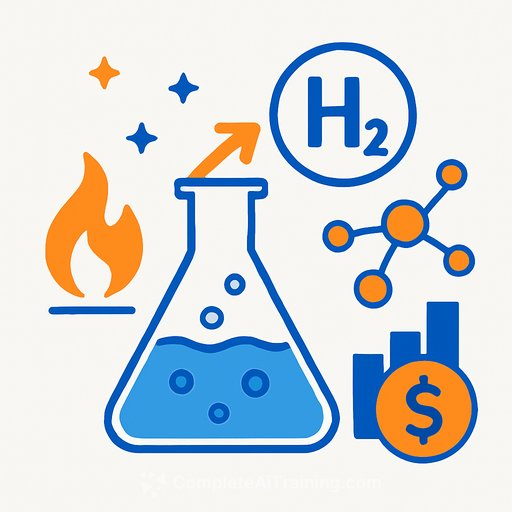AI-led discovery cuts the cost of clean hydrogen catalysts
Iridium has been the gold-standard catalyst for oxygen evolution in water electrolysis - and a major cost and supply bottleneck. Using an AI-enabled "megalibrary" platform, researchers identified a multi-metal oxide that matches, and in some tests exceeds, commercial iridium materials at far lower cost.
Developed at Northwestern University with the Toyota Research Institute, the approach scaled from chip-level screening to a device demonstration, showing a credible path from discovery to application.
Why iridium limits green hydrogen scale-up
Oxygen evolution reaction (OER) is the sluggish half of water splitting. Iridium-based catalysts improve efficiency, but the metal is rare, expensive (around $5,000/oz), and typically a byproduct of platinum mining. There isn't enough global supply to support multi-terawatt electrolyzer deployment.
Megalibraries: a practical data factory for materials
The megalibrary is a chip that hosts millions of distinct nanoparticles. Arrays of microtips print tiny dots of metal salts; heating reduces them to single nanoparticles with controlled composition and size. A robotic system then screens catalytic activity, building a high-quality dataset for human and machine learning.
In this study, the team fabricated a library of 156 million particles spanning combinations of ruthenium, cobalt, manganese, and chromium. Screening highlighted a specific oxide composition - Ru52 Co33 Mn9 Cr6 - with OER performance on par with, and in some cases better than, iridium-based benchmarks.
What this changes for R&D and deployment
- Cost and supply: Shifts dependence away from a scarce precious metal toward abundant elements, improving scalability and supply-chain resilience.
- Throughput and data: Millions of compositions on a chip compress years of trial-and-error into days, yielding datasets that feed AI models for targeted design.
- Device relevance: The catalyst was scaled beyond the chip and tested in a device, moving discovery closer to electrolyzer integration and field validation.
- Testing discipline: Future work should emphasize durability, poisoning tolerance, manufacturing consistency, and standardized benchmarking (e.g., ECSA-normalized activity, accelerated stress tests).
- Portfolio thinking: Multi-metal synergy opens space for compositionally complex oxides that can be tuned for activity, stability, and cost simultaneously.
Key technical notes
- Library size: 156 million nanoparticles
- Element palette: Ru, Co, Mn, Cr
- Best candidate: Ru52 Co33 Mn9 Cr6 oxide
- Outcome: Matched or exceeded commercial iridium OER performance in laboratory tests; material was scaled and operated in a device
- Collaboration: Northwestern University and Toyota Research Institute
- Publication: Journal of the American Chemical Society - "Accelerating the pace of oxygen evolution reaction catalyst discovery through megalibraries" (JACS)
Context: hydrogen production and OER
Water electrolysis splits H2O into hydrogen and oxygen. The OER side is kinetics-limited and sets much of the efficiency and cost structure. Lower-cost, high-activity OER catalysts directly impact electrolyzer capex and operating efficiency.
For background on electrolysis pathways and their role in clean energy systems, see the U.S. Department of Energy overview (DOE: Hydrogen Production via Electrolysis).
A note on hydrogen and fusion
Hydrogen also fuels stellar fusion - the process powering the sun - at temperatures near 100 million °C in plasma. While fusion is separate from today's electrolyzer technology, both contexts underline hydrogen's central role in future energy systems.
What to watch next
- Independent benchmarking versus state-of-the-art iridium catalysts across pH, temperature, and current density ranges.
- Long-term stability and degradation mechanisms under device-relevant duty cycles.
- Manufacturing routes for consistent particle size/composition at scale and integration with commercial electrode architectures.
- Expansion of the megalibrary + AI workflow to other bottleneck materials (e.g., PEM anode supports, CO2RR catalysts, solid-state electrolyte chemistries).
Build your AI skill stack for lab and materials R&D
If you're developing applied AI capabilities for high-throughput experimentation, data engineering, or lab automation, explore curated learning paths here: Latest AI courses.
Your membership also unlocks:






